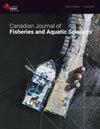将研究调查数据与其他数据源整合的空间变化可捕获性:涉及观察者样本的案例研究、行业合作调查和捕食者作为样本
IF 2.2
2区 农林科学
Q2 FISHERIES
Canadian Journal of Fisheries and Aquatic Sciences
Pub Date : 2023-06-15
DOI:10.1139/cjfas-2023-0051
引用次数: 2
摘要
时空模型被广泛应用于研究调查数据的标准化,并越来越多地用于从其他数据源生成密度图和指数。我们开发了一个时空建模框架,该框架集成了研究调查数据(被视为“参考数据集”)和其他数据源(“非参考数据集),同时估计非参考数据集中空间变化的可捕获性。我们用两个案例研究证明了这一点。第一次涉及新西兰查塔姆海隆多刺狗鱼(Squalus acanthias)的底拖网调查和观察员数据。第二次涉及鳕鱼捕食者作为幼年雪蟹(Chionoecetes opilio)丰度的采样器,结合了白令海东部的行业合作调查和底拖网研究调查。我们的综合模型利用了单个数据源的优势(参考数据集的质量和非参考数据的数量),同时通过估计的空间变化的可捕性来降低非参考数据集影响。它们允许生成更长时间段的年度密度图,并提供一个单一指数,而不是多个指数,每个指数覆盖的时间更短。本文章由计算机程序翻译,如有差异,请以英文原文为准。
Spatially varying catchability for integrating research survey data with other data sources: case studies involving observer samples, industry-cooperative surveys, and predators-as-samplers
Spatio-temporal models are widely applied to standardise research survey data and are increasingly used to generate density maps and indices from other data sources. We developed a spatio-temporal modelling framework that integrates research survey data (treated as a “reference dataset”) and other data sources (“non-reference datasets”) while estimating spatially varying catchability for the non-reference datasets. We demonstrated it using two case studies. The first involved bottom trawl survey and observer data for spiny dogfish (Squalus acanthias) on the Chatham Rise, New Zealand. The second involved cod predators as samplers of juvenile snow crab (Chionoecetes opilio) abundance, integrated with industry-cooperative surveys and a bottom trawl research survey in the eastern Bering Sea. Our integrated models leveraged the strengths of individual data sources (the quality of the reference dataset and the quantity of non-reference data), while downweighting the influence of the non-reference datasets via the estimated spatially varying catchabilities. They allowed for the generation of annual density maps for a longer time-period, and for the provision of one single index rather than multiple indices each covering a shorter time-period.
求助全文
通过发布文献求助,成功后即可免费获取论文全文。
去求助
来源期刊

Canadian Journal of Fisheries and Aquatic Sciences
农林科学-海洋与淡水生物学
CiteScore
4.60
自引率
12.50%
发文量
148
审稿时长
6-16 weeks
期刊介绍:
The Canadian Journal of Fisheries and Aquatic Sciences is the primary publishing vehicle for the multidisciplinary field of aquatic sciences. It publishes perspectives (syntheses, critiques, and re-evaluations), discussions (comments and replies), articles, and rapid communications, relating to current research on -omics, cells, organisms, populations, ecosystems, or processes that affect aquatic systems. The journal seeks to amplify, modify, question, or redirect accumulated knowledge in the field of fisheries and aquatic science.
 求助内容:
求助内容: 应助结果提醒方式:
应助结果提醒方式:


